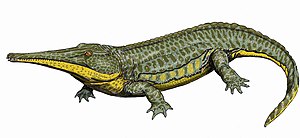A good example of covergent evolution is the phyotsaurs.
They look like such kind of crocodile-ish thing, perhaps with a narrow nose like a gharial.
Smilosuchus adamanensis

For a long while, folks thought that phytosaurs were ancestors of crocodiles but more recent evidence has shown that they are not closely related.
The early Crurotarsi were not very crocodile looking: somewhat lizard like with rounded snouts and broad bodies. The Crurotarsi diverged about 250 million years ago, into the phytosaurs and the archosaurs. The phytosaurs fairly rapidly evolved the above crocodile-like appearance and then became extinct around 200 million years ago.
Meanwhile the archosaurs, the “sister taxon” of the phytosaurs, underwent quite a different evolution. It diverged separately into bird-line archosaurs and crocodile-line archosaurs, but neither of these contained members that looked terribly bird-like or crocodile-like for tens of millions of years. The crocodilians developed to have much the same shape, and it seems diet, as the phytosaurs.




